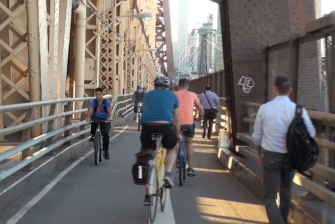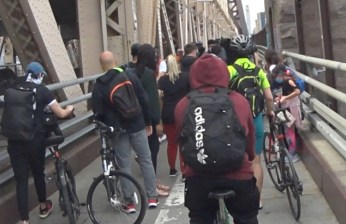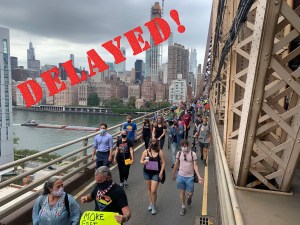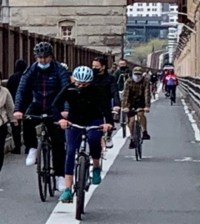No, Seriously, DOT, Give Cyclists and Pedestrians Emergency Space on the Queensboro Bridge
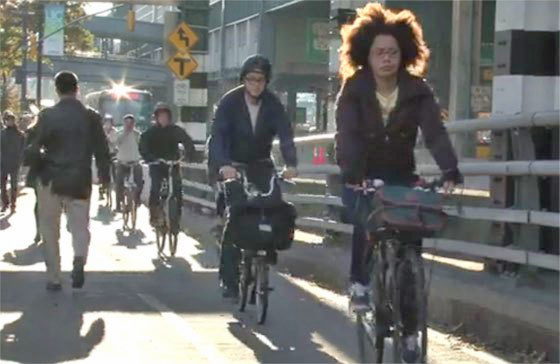
The city needs to — no, seriously, this time — give pedestrians their own “desperately needed travel space” on the Queensboro Bridge to ensure that all commuters are able to practice “the six-feet social distancing protocols our government and healthcare professionals have recommended,” a Queens City Council Member is demanding.
In a letter to the Department of Transportation sent on Wednesday, Costa Constantinides put a new context — the virus — on his longstanding call for separate lanes for pedestrians and cyclists, who currently share the narrow northernmost lane on the crowded span.
“It narrows down to less than nine feet in width,” he wrote. “Even the worst math student can tell you it’s impossible for pedestrians and cyclists heading back and forth along to keep a safe six feet from one another.”
Of course, it’s not the first time that local politicians and activists have called for the south outer roadway to be reallocated for pedestrians (check out our prior coverage here, here and here). But the coronavirus crisis only strengthens the case for more space so pedestrians and cyclists can get between Queens and Manhattan in a socially responsible manner.
Cycling continues to be a key way for frontline workers and essential employees to get around. On Monday, March 2, 3,589 cyclists used the span, according to the DOT. On Monday, April 6, which was also a nice spring day, that number had only dropped to 2,835, a drop of 21 percent, even as total car mileage has dropped more than 80 percent in the city, according to StreetLight Data.
And car lanes on the Queensboro Bridge are so empty that drivers are able to speed with impunity, as Streetsblog showed in a video:
Constantinides’s letter is just the latest example of a politician seeing the virus as, as he put it, “an opportune time to re-purpose under-utilized car space and find smarter ways to move around.
Earlier this week, Council Speaker Corey Johnson also called for the de Blasio administration to start planning — now — for a post-COVID-19 future when residents will not want to go back to congestion, pollution and streets endangered by millions of vehicles.
“This crisis has amplified so many issues that already existed, and one glaring example is the amount of space we allocate to cars,” Johnson told Streetsblog. “We should use this pandemic as a time to get creative about how we open streets to people and bikes.”
Mayor de Blasio said on Tuesday that he would issue a plan for reductions in car use, but said such a plan is not yet being drawn up.
“I intend to create a plan that will do all of that [reduce car use],” the mayor said. “Because when we finish beating this enemy, we’ve got another enemy up ahead that’s fierce. And that is bearing down on us quickly and we’re going to all have to work together to fight. And getting out of our cars to the maximum extent possible is part of that fight. So yes, you will see those plans for the future of the city.”
That said, the mayor has done very little — in the present crisis — to provide cyclists and pedestrians easier and safer ways to get around. The administration did create two temporary protected bike lanes in Brooklyn and Manhattan, but it’s other main change — short stretches of car-free streets — was canceled after just 11 days.
And the mayor also cut $10 million from the DOT’s Vision Zero program in his latest round of emergency budget trims.
The DOT had not responded to Constantinides’s letter by 1 p.m. on Thursday. The agency did not return a request for comment from Streetsblog.
